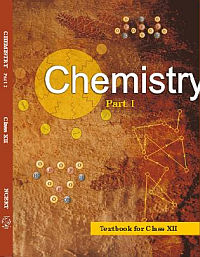(HOT) UPSC Current Affairs 2025 PDF
NEW! The Gist (NOV-2025) | E-BOOKS
(Download) NCERT Book For Class XII : Chemistry (Part -1)

(Download) NCERT Book For Class XII : Chemistry (Part-1)
Table of Contents
- Unit 1 The Solid State
1.1 General Characteristics of Solid State
1.2 Amorphous and Crystalline Solids
1.3 Classification of Crystalline Solids
1.4 Crystal Lattices and Unit Cells
1.5 Number of Atoms in a Unit Cell
1.6 Close-Packed Structures
1.7 Packing Efficiency
1.8 Calculations Involving Unit Cell Dimensions
1.9 Imperfections in Solids
1.10 Electrical Properties
1.11 Magnetic Properties - Unit 2 Solutions
2.1 Types of Solutions
2.2 Expressing Concentration of Solutions
2.3 Solubility
2.4 Vapour Pressure of Liquid Solutions
2.5 Ideal and Non-ideal Solutions
2.6 Colligative Properties and Determination of Molar Mass
2.7 Abnormal Molar Masses - Unit 3 Electrochemistry
3.1 Electrochemical Cells
3.2 Galvanic Cells
3.3 Nernst Equation
3.4 Conductance of Electrolytic Solutions
3.5 Electrolytic Cells and Electrolysis
3.6 Batteries
3.7 Fuel Cells
3.8 Corrosion - Unit 4 Chemical Kinetics
4.1 Rate of a Chemical Reaction
4.2 Factors Influencing Rate of a Reaction
4.3 Integrated Rate Equations
4.4 Pseudo First Order Reaction
4.5 Temperature Dependence of the Rate of a Reaction
4.6 Collision Theory of Chemical Reactions - Unit 5 Surface Chemistry
5.1 Adsorption
5.2 Catalysis
5.3 Colloids
5.4 Classification of Colloids
5.5 Emulsions
5.6 Colloids Around Us - Unit 6 General Principles and Processes of Isolation of
Elements
6.1 Occurrence of Metals
6.2 Concentration of Ores
6.3 Extraction of Crude Metal from Concentrated Ore
6.4 Thermodynamic Principles of Metallurgy
6.5 Electrochemical Principles of Metallurgy
6.6 Oxidation Reduction
6.7 Refining
6.8 Uses of Aluminium, Copper, Zinc and Iron - Unit 7 The p-Block Elements
7.1 Group 15 Elements
7.2 Dinitrogen
7.3 Ammonia
7.4 Oxides of Nitrogen
7.5 Nitric Acid
7.6 Phosphorus – Allotropic Forms
7.7 Phosphine
7.8 Phosphorus Halides
7.9 Oxoacids of Phosphorus
7.10 Group 16 Elements
7.11 Dioxygen
7.12 Simple Oxides
7.13 Ozone
7.14 Sulphur – Allotropic Forms
7.15 Sulphur Dioxide
7.16 Oxoacids of Sulphur
7.17 Sulphuric Acid
7.18 Group 17 Elements
7.19 Chlorine
7.20 Hydrogen Chloride
7.21 Oxoacids of Halogens
7.22 Interhalogen Compounds
7.23 Group 18 Elements - Unit 8 The d-and f-Block Elements
8.1 Position in the Periodic Table
8.2 Electronic Configurations of the d-Block Elements
8.3 General Properties of the Transition Elements (d-Block)
8.4 Some important Compounds of Transition Elements
8.5 The Lanthanoids
8.6 The Actinoids
8.7 Some Applications of d-and f-Block Elements - Unit 9 Coordination Compounds
9.1 Werner's Theory of Coordination Compounds
9.2 Definition of Some Important Terms Pertaining to Coordination Compounds
9.3 Nomenclature of Coordination Compounds
9.4 Isomerism in Coordination Compounds
9.5 Bonding in Coordination Compounds
9.6 Bonding in Metal Carbonyls
9.7 Stability of Coordination Compounds
9.8 Importance and Applications of Coordination Compounds
Download Free NCERT PDF
Printed Study Material for IAS Exam (UPSC Pre Cum Mains Combo)
Get Gist of NCERT Books Study Kit for UPSC Exams
Go Back To NCERT Books Main Page
Courtesy : NCERT



